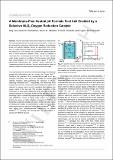| dc.contributor.author | Yan, Bing | |
| dc.contributor.author | Concannon, Nolan M. | |
| dc.contributor.author | Milshtein, Jarrod David | |
| dc.contributor.author | Brushett, Fikile R | |
| dc.contributor.author | Surendranath, Yogesh | |
| dc.date.accessioned | 2018-04-30T19:32:47Z | |
| dc.date.available | 2018-04-30T19:32:47Z | |
| dc.date.issued | 2017-05 | |
| dc.identifier.issn | 1433-7851 | |
| dc.identifier.issn | 1521-3773 | |
| dc.identifier.uri | http://hdl.handle.net/1721.1/115115 | |
| dc.description.abstract | Polymer electrolyte membranes employed in contemporary fuel cells severely limit device design and restrict catalyst choice, but are essential for preventing short‐circuiting reactions at unselective anode and cathode catalysts. Herein, we report that nickel sulfide Ni[subscript 3]S[subscript 2] is a highly selective catalyst for the oxygen reduction reaction in the presence of 1.0 m formate. We combine this selective cathode with a carbon‐supported palladium (Pd/C) anode to establish a membrane‐free, room‐temperature formate fuel cell that operates under benign neutral pH conditions. Proof‐of‐concept cells display open circuit voltages of approximately 0.7 V and peak power values greater than 1 mW cm[superscript −2], significantly outperforming the identical device employing an unselective platinum (Pt) cathode. The work establishes the power of selective catalysis to enable versatile membrane‐free fuel cells. | en_US |
| dc.description.sponsorship | National Science Foundation (U.S.) (Award CHE-1454060) | en_US |
| dc.language.iso | en_US | |
| dc.publisher | Wiley Blackwell | en_US |
| dc.relation.isversionof | http://dx.doi.org/10.1002/anie.201702578 | en_US |
| dc.rights | Creative Commons Attribution-Noncommercial-Share Alike | en_US |
| dc.rights.uri | http://creativecommons.org/licenses/by-nc-sa/4.0/ | en_US |
| dc.source | Prof. Surendranath via Erja Kajosalo | en_US |
| dc.title | A Membrane-Free Neutral pH Formate Fuel Cell Enabled by a Selective Nickel Sulfide Oxygen Reduction Catalyst | en_US |
| dc.type | Article | en_US |
| dc.identifier.citation | Yan, Bing et al. “A Membrane-Free Neutral pH Formate Fuel Cell Enabled by a Selective Nickel Sulfide Oxygen Reduction Catalyst.” Angewandte Chemie International Edition 56, 26 (May 2017): 7496–7499 © 2017 Wiley Blackwell | en_US |
| dc.contributor.department | Massachusetts Institute of Technology. Department of Chemical Engineering | en_US |
| dc.contributor.department | Massachusetts Institute of Technology. Department of Chemistry | en_US |
| dc.contributor.department | Massachusetts Institute of Technology. Department of Materials Science and Engineering | en_US |
| dc.contributor.approver | Surendranath, Yogesh | en_US |
| dc.contributor.mitauthor | Yan, Bing | |
| dc.contributor.mitauthor | Concannon, Nolan M. | |
| dc.contributor.mitauthor | Milshtein, Jarrod David | |
| dc.contributor.mitauthor | Brushett, Fikile R | |
| dc.contributor.mitauthor | Surendranath, Yogesh | |
| dc.relation.journal | Angewandte Chemie International Edition | en_US |
| dc.eprint.version | Author's final manuscript | en_US |
| dc.type.uri | http://purl.org/eprint/type/JournalArticle | en_US |
| eprint.status | http://purl.org/eprint/status/PeerReviewed | en_US |
| dspace.orderedauthors | Yan, Bing; Concannon, Nolan M.; Milshtein, Jarrod D.; Brushett, Fikile R.; Surendranath, Yogesh | en_US |
| dspace.embargo.terms | N | en_US |
| dc.identifier.orcid | https://orcid.org/0000-0001-7874-725X | |
| dc.identifier.orcid | https://orcid.org/0000-0001-8322-5106 | |
| dc.identifier.orcid | https://orcid.org/0000-0002-7361-6637 | |
| dc.identifier.orcid | https://orcid.org/0000-0003-1016-3420 | |
| mit.license | OPEN_ACCESS_POLICY | en_US |
